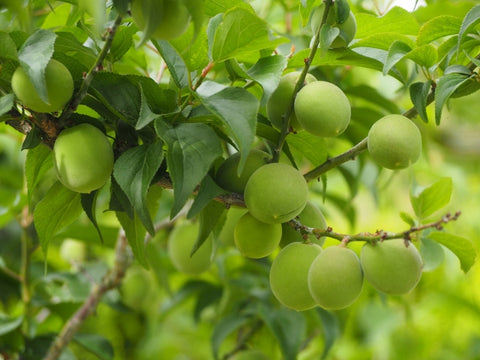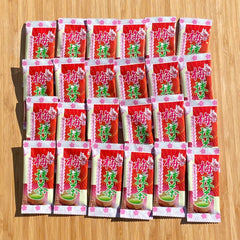Ume, an Important Plant for a Japanese Life
Everyone knows Sakura (Cherry blossoms) is an important and essential part of Japanese lives. How about Ume (Japanese plum)? Did you know Ume is also an essential plant for a Japanese life?
As well as enjoying Sakura-viewing, we enjoy viewing blossoms of Ume in February to March. In fact, Ume-viewing is an old custom than Sakura-viewing having occurred since the Nara period (AD 710-794).

Ume blossoms
The fruit of Ume picked in May-June, has an important role in Japanese food culture. Traditionally, people make preserved foods with Ume during this season. This work is called Umeshigoto (Ume work).
If you would like to know more about the Ume (technical name: Prunus mume) and the Ume preserving, read this article. Seasonal Ume (梅,Japanese Plum) Preserving


This time I’ll introduce a traditional home remedy made from Ume.
Ume Juice Concentrate(Ume ekisu)
The Ume juice concentate (Bainiku Ekisu or Ume Ekes in Japanese) has appeared in the book written by the doctor in 1817 about folk medicines in all of Japan, and shown the method of making, the usage and the effects for infectious diseases, food poisoning and indigestion.
In fact, Ume and Ume juice concentrate have extensive documents showing effectiveness in infectious diseases, indigestion, keeping blood pressure and liver's health, etc. Ume is the king of alkaline food which balances your body if your body is in acidic environment which may cause to diseases.
The concentrate has been especially made in the area where Ume has been produced. The bottle of the concentrate has been kept on our shelf as I live in one of the famous Ume producing areas. My neighbor, who is late 70S, keeps saying that she has been healthy and hasn’t got any disease as she takes the concentrate every day. She makes the concentration everyday during the season, picking Ume from her garden.
I'll show you hot to make it. You would be surprised how much you need to concentrate. But once it's done, you can keep it in a cool place for more than 10 years.
How to Make Ume-Juice Concentrate
Use unripe fruits.

Smash the fruits, removing the stones.

4kg of Ume is done.

Process the Ume through the juicer to separate the liquid and the pulp.

Simmer the liquid continuously, for 6-8 hours, periodically skimming froth from the surface.

It's finally done when it gets very thick and solid with tar-looking!

You can only make 20-30g of the concentrate from 1kg of Ume!! It tastes very very sour. I never had such sour food in my life. Only a pea-sized portion on the tip of a chopstick is enough for one day. I take it everyday, deleted in water.
Try the concentrate or preserved Ume foods if you have a chance.
It's interesting to know about food culture and home remedies made from plants. If you are interested in the food culture and home remedy with Yomogi, read here.
What's Yomogi (Japanese mugwort)? The History as Food and Herbal Medicine
Related Articles
Seasonal Ume (梅,Japanese Plum) Preserving
Today's Recommendations
Tea
Kyoto Kouyoucha, Ume shiso konbu matcha blend by Kouyoudo - 2g x 12 packets (Konbucha)
This tea blend tea includes matcha, ume (Japanese apricot) ,powdered shiso (perilla leaves) , and kombu (kelp seaweed) which together creates a savory, mellow, and salty combination. Enjoyable as a drink, or as a flavoring in your cooking.


Mannen: Ume Matcha - Japanese Plum, Matcha & Kelp Soup Tea Powder
This tea blend tea includes matcha, ume (Japanese apricot) , kombu (kelp seaweed) and rice cracker bits. Enjoyable as a drink, or as a flavoring in your cooking.

Salt
Amabito no Moshio Gourmet Ume Plum Seaweed Salt by Kamagari Bussan
Dried powdered Nanko-Ume, top variety of Ume, from Kishu, Wakayama is blended with the salt Moshio, made from seawater and sargassum(brown seaweed) in Setonaikai(the inland Sea, Japan), includes umami extracted from seaweed.

Furoshiki Wrapping Cloth
Iyo Yuinoh Center, Furoshiki: The Plum Garden in Kameido (large)
Furoshiki wrapping cloth printed with a beautiful woodblock print: 'The Ume Garden in Kameido' (from One Hundred Famous Views of Edo) drawn by Utagawa Hiroshige (1797-1858), also known as Ando Hiroshige, was an artist active in the Edo period.
You can carry things such as your lunch to your work or a bottle of wine to the party by wrapping with the cloth.



